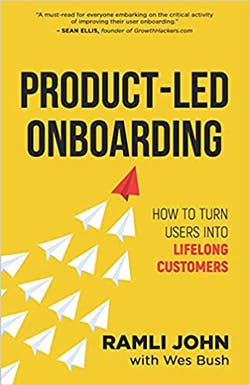
The irony in all of this is that the user onboarding is usually the only aspect of a product that every single user will experience. So the million-dollar question is: are you wasting the investment in the marketing, sales, and product teams with an experience that neglects the needs of first-time users?
The backbone of this book is the six-step EUREKA framework.
It encompasses:
- Building a cross-functional onboarding team.
- Identifying your onboarding success criteria.
- Minimizing the time it takes for users to experience the value of a product.
- Simplifying the signup process and designing the first product experience for new users.
- Creating behavior-based onboarding emails, in-app messages, and additional communication methods.
- Involving sales and high-touch support in the onboarding process.
Chapter 1
User onboarding isn't just about the first 'aha' moment. And the first 'aha' doesn't mean "once the user signs up". These 'aha' moments start at the first touchpoint. A touchpoint is any interaction that users have with a business.
These touch points could be something like seeing the link on a search results page, watching a video on Facebook, or reading a newsletter their colleague forwarded them.
A first successful touchpoint helps people visualize a product in the context of their own situation.
Successful users go through a series of 'aha' moments before, during, and after they sign up for a product. With each 'aha' moment, users receive increasing value from a product in a series of steps; they jump to a higher value as they perceive and experience a product's capabilities.
The user onboarding journey is not about driving users to a single 'aha' moment, but instead guiding them through a series of 'aha' moments.
The acquisition phase is just as important as the activation phase. You need to plant the seed of future value at the very first touchpoint—whether that's in a Facebook ad, a referral from a friend, or an invite email from a colleague. Clear product position across all of these helps screen out those who shouldn't be signing up for a product (especially early on) and allows the company to focus more time on people who should be using it.
It costs up to 5 times more to acquire a new customer than to retain an existing customer.
The user onboarding experience ends when a signal is received that the user if gaining meaningful value from a product and is likely to continue using it.
What is user onboarding anyways?
User onboarding is the process that takes people from perceiving, experience, and adopting the product's value to improve their lives.
Three key onboarding success milestones:
- The moment of value perception (MVP): This is when users first visualize a product in the context of their situation. For the initial onboarding of new users, the MVP usually occurs before signing up.
- The Moment of Value Realization (MVR): This is when users first experience a product's value and achieve their desired outcome with the product for the first time.
- The Moment of Value Adoption (MVA): This is when users start using a product regularly and integrate it into their life or workflow.
Here's an example using Slack.
- Moment of Value Perception: Users first grasp how Slack can help their team communicate and share information more efficiently than email or other messaging tools.
- Moment of Value Realization: Users send their first message to a colleague using Slack.
- Moment of Value Adoption: Users from the same team send 2,000 messages.
Note-Doing something once is not enough to build a habit. Habits are built through repetition. This is important because users must break out of their existing habits and bring in the habits your solution is enabling.
User onboarding is a process. It involves a series of actions that uses both tools and people to provide new users the knowledge, skills, and behaviors to interact with a product effectively.
After the initial onboarding experience for new users, they can (and should) go through a new cycle of perceiving, experiencing, and adopting additional features, capabilities, or use cases of your product. Much like a flywheel, gaining momentum to start requires a considerable effort. New users have to overcome friction, such as letting go of old habits or moving past the anxiety of change.





